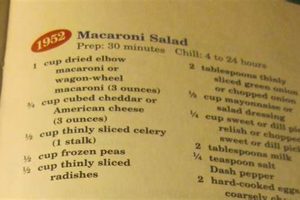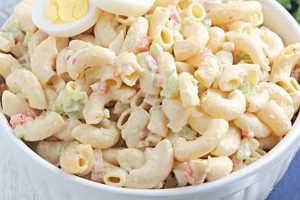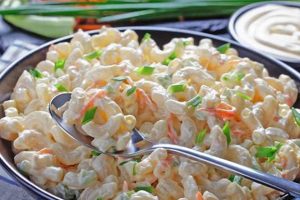A vibrant, colorful pasta salad typically features a medley of vegetables, often diced or finely chopped, creating a “jewel-like” appearance. Common ingredients include bell peppers (red, yellow, orange, green), celery, red onion, and sometimes peas or carrots. These are combined with cooked elbow macaroni and dressed in a mayonnaise-based sauce, which can be flavored with vinegar, mustard, sugar, and seasonings. Variations may incorporate hard-boiled eggs, cheese, or different protein elements like ham or tuna.
This type of dish is a popular choice for potlucks, picnics, and barbecues due to its ease of preparation, transportability, and crowd-pleasing nature. Its colorful presentation makes it visually appealing, while the variety of textures and flavors offers a satisfying culinary experience. The cool, creamy nature of the dish also makes it particularly refreshing in warmer weather. Historically, macaroni salads gained popularity in the mid-20th century as refrigeration became more common, enabling safe preparation and storage of mayonnaise-based dishes. The versatility of the dish allows for numerous adaptations based on regional preferences and seasonal ingredients.
The following sections will delve into specific ingredient selections, provide step-by-step preparation instructions, and offer suggestions for variations and serving ideas to elevate this classic side dish.
Tips for a Stunning Macaroni Salad
Elevating a simple macaroni salad to something truly special involves attention to detail and a few key techniques. These tips offer guidance on ingredient selection, preparation methods, and presentation for optimal results.
Tip 1: Uniform Vegetable Cuts: Consistent sizing of vegetables ensures even cooking and enhances the visual appeal. Aim for a small dice, approximately -inch, for optimal texture and aesthetic presentation.
Tip 2: Blanch Certain Vegetables: Briefly blanching vegetables like peas and carrots helps maintain their vibrant color and crisp-tender texture while reducing raw flavors that may clash with the creamy dressing.
Tip 3: Cook Macaroni Al Dente: Overcooked pasta results in a mushy salad. Cook the macaroni until firm to the bite (al dente) to maintain its shape and texture within the salad.
Tip 4: Chill Ingredients Thoroughly: Using chilled ingredients, including the cooked pasta and vegetables, prevents the mayonnaise-based dressing from becoming thin and watery. This also helps maintain food safety.
Tip 5: Balance Flavors in the Dressing: Achieving a balanced flavor profile in the dressing is crucial. The sweetness of sugar, the tang of vinegar, and the sharpness of mustard should complement each other without any single flavor dominating.
Tip 6: Season Gradually: Add salt and pepper gradually, tasting the dressing as adjustments are made. This ensures proper seasoning without over-salting the finished salad.
Tip 7: Allow Flavors to Meld: Refrigerate the prepared salad for at least an hour before serving to allow the flavors to meld and develop fully. This enhances the overall taste experience.
By following these tips, one can create a visually stunning and flavorful macaroni salad suitable for any occasion. Attention to these details elevates the dish from a simple side to a culinary highlight.
The following section provides a complete recipe incorporating these techniques for a truly exceptional macaroni salad experience.
1. Vibrant Vegetables
Vibrant vegetables are fundamental to both the aesthetic appeal and nutritional value of a jewel macaroni salad. Their varied colors and textures contribute significantly to the jewel descriptor, transforming a simple macaroni salad into a visually striking dish. The selection of brightly colored vegetables not only enhances presentation but also introduces a range of vitamins, minerals, and antioxidants. Red bell peppers offer vitamin C, while orange and yellow varieties provide beta-carotene. Green bell peppers contribute vitamin K, and the inclusion of darker greens like spinach or chopped broccoli further amplifies the nutritional density.
The careful balance of these vibrant vegetables creates a visually engaging mosaic. Consider a combination of diced red bell pepper, finely chopped celery, thinly sliced red onion, and blanched green peas. This blend provides not only a spectrum of colors but also varying degrees of crunch and subtle flavor differences. Blanching certain vegetables, such as peas or carrots, maintains their bright hues and ensures optimal texture within the salad, preventing them from becoming overly soft or losing their color vibrancy during chilling.
The strategic use of vibrant vegetables in a jewel macaroni salad elevates the dish beyond a simple side. It becomes a centerpiece offering a complex interplay of flavors, textures, and nutritional benefits. This understanding allows for creative variations, incorporating seasonal vegetables and adapting the color palette to specific occasions or dietary preferences, showcasing the versatility and adaptability of this classic dish.
2. Creamy Dressing
The creamy dressing serves as the unifying element in a jewel macaroni salad recipe, binding the diverse vegetables and pasta into a cohesive whole. Its texture and flavor profile significantly influence the overall sensory experience. A classic mayonnaise-based dressing provides the foundational creaminess, while additions such as vinegar introduce a tangy counterpoint, and mustard contributes a subtle sharpness. This balance prevents the richness of the mayonnaise from becoming overwhelming, creating a harmonious blend that complements the other ingredients. For example, a dressing with excessive sweetness might clash with the natural flavors of the vegetables, while insufficient acidity could result in a bland, uninspired salad.
The dressing also plays a crucial role in the preservation and presentation of the salad. The emulsification of the mayonnaise helps prevent the vegetables from drying out, maintaining their texture and freshness. Furthermore, the dressing acts as a canvas for flavor infusions. Incorporating herbs like dill or chives introduces aromatic complexity, while spices like paprika or celery seed offer subtle nuances. The choice of dressing ingredients can be tailored to complement specific vegetable combinations. A lighter vinaigrette might be preferred for a salad emphasizing delicate flavors, while a richer, creamier dressing better suits bolder vegetable choices and heavier additions like hard-boiled eggs or cheese. Understanding these nuances allows for customized flavor profiles and ensures the dressing enhances, rather than masks, the individual components of the salad.
Mastering the balance of flavors and textures within the creamy dressing is essential for a successful jewel macaroni salad. This understanding enables informed decisions regarding ingredient selection, proportions, and complementary flavor additions. The dressing, therefore, becomes more than a simple binding agent; it transforms into a defining characteristic of the dish, elevating it from a basic pasta salad to a carefully composed culinary creation.
3. Al Dente Macaroni
The term “al dente,” meaning “to the tooth” in Italian, describes pasta cooked to a firm yet tender consistency. Achieving this specific texture is crucial for a successful jewel macaroni salad recipe, directly impacting the final dish’s overall quality and enjoyment. Overcooked macaroni becomes mushy and absorbs too much dressing, resulting in a heavy, less appealing salad. Conversely, undercooked pasta offers an unpleasant, tough texture. Al dente macaroni provides the ideal balance, maintaining its shape and contributing a pleasant chewiness to the salad.
- Texture and Mouthfeel
Al dente macaroni contributes a desirable textural element to the salad, contrasting with the creamy dressing and the crispness of the vegetables. This interplay of textures enhances the overall sensory experience. A firm bite provides a more satisfying mouthfeel, preventing the salad from becoming overly soft or homogenous. Imagine biting into a salad where the pasta offers a slight resistance, complementing the other ingredients rather than blending into a uniform softness. This distinct textural presence is a defining characteristic of a well-made macaroni salad.
- Dressing Absorption
Properly cooked al dente macaroni absorbs the dressing more evenly without becoming overly saturated. This ensures that the flavor of the dressing is distributed throughout the salad while maintaining the individual integrity of the pasta pieces. Overcooked pasta, on the other hand, tends to absorb excessive dressing, leading to a diluted flavor and a less appealing, soggy texture. The controlled absorption of al dente macaroni allows the flavors of the dressing and the vegetables to shine through without being masked by an overabundance of dressing.
- Visual Appeal
Al dente macaroni maintains its shape, contributing to the visual appeal of the jewel macaroni salad. The individual pieces remain distinct, showcasing their form and texture. This visual separation enhances the “jewel” effect of the colorful vegetables, allowing their vibrant hues to stand out against the backdrop of the pasta. Overcooked pasta, in contrast, tends to clump together, detracting from the visual appeal and creating a less appetizing presentation. The distinct shapes of al dente macaroni contribute to the overall aesthetic presentation of the salad.
- Storage and Serving
Al dente macaroni holds its shape better during storage, preventing the salad from becoming overly mushy or compressed. This is particularly important when making the salad ahead of time for events like potlucks or picnics. The structural integrity of al dente pasta ensures that the salad retains its desirable texture even after refrigeration, allowing it to be served at its best. This characteristic contributes to the convenience and transportability of the dish, making it a practical choice for various occasions.
The significance of al dente macaroni in a jewel macaroni salad recipe extends beyond mere cooking technique. It directly impacts the texture, flavor, visual appeal, and overall enjoyment of the dish. By achieving this ideal consistency, one ensures a harmonious blend of flavors and textures, resulting in a truly satisfying and visually appealing culinary experience. Mastering this fundamental element elevates the salad from a simple side dish to a carefully crafted culinary creation, highlighting the importance of seemingly small details in achieving culinary excellence.
4. Balanced Flavors
Balanced flavors are essential to a successful jewel macaroni salad recipe. The interplay of sweet, sour, salty, and savory elements creates a harmonious flavor profile that elevates the dish beyond a simple combination of ingredients. This balance prevents any single flavor from dominating, allowing the individual componentsthe vegetables, pasta, and dressingto complement each other. For instance, the sweetness of sugar or relish balances the tanginess of vinegar or lemon juice in the dressing, while the saltiness of the dressing enhances the natural flavors of the vegetables. A well-balanced flavor profile ensures the complexity and enjoyment of each bite.
Consider the impact of unbalanced flavors. An overly sweet dressing can mask the delicate flavors of the vegetables, while excessive acidity can make the salad unpleasantly tart. Similarly, too much salt can overpower the other ingredients, creating a one-dimensional taste experience. The careful calibration of these elements is crucial. A classic example of balanced flavors in a jewel macaroni salad recipe involves a creamy mayonnaise-based dressing tempered by the tang of apple cider vinegar, the subtle sweetness of granulated sugar, and the savory notes of Dijon mustard. This combination creates a complex flavor profile that complements the diverse array of vegetables typically found in the salad, such as crisp celery, sweet bell peppers, and pungent red onion. The balanced dressing enhances, rather than overwhelms, these individual flavors.
Achieving balanced flavors requires careful consideration of ingredient proportions and an understanding of how different flavor profiles interact. This understanding enables informed adjustments to the recipe based on personal preferences and the specific ingredients used. The practical significance of this balance lies in the creation of a macaroni salad that is not only visually appealing but also offers a complex and satisfying culinary experience. The nuanced interplay of flavors elevates the dish from a simple side to a carefully composed culinary creation, demonstrating the importance of balanced flavors in achieving culinary excellence. This attention to detail transforms the jewel macaroni salad from a basic dish into a flavorful and memorable culinary experience.
5. Proper Chilling
Proper chilling is a critical factor in the creation of a successful jewel macaroni salad. It directly impacts food safety, texture, and flavor, influencing the overall quality and enjoyment of the dish. Chilling not only inhibits bacterial growth, ensuring the salad remains safe for consumption but also preserves the structural integrity of the ingredients and allows the flavors to meld and develop fully. Insufficient chilling can compromise these aspects, leading to a less appealing and potentially unsafe dish.
- Food Safety
Chilling inhibits the growth of harmful bacteria that can cause foodborne illness. Mayonnaise-based dressings, commonly used in macaroni salad, are particularly susceptible to bacterial growth at room temperature. Thorough chilling, maintaining a temperature below 40F (4C), significantly reduces this risk. This is crucial for maintaining the safety of the salad, especially when prepared in advance or served at outdoor events.
- Texture Preservation
Chilling helps maintain the desired texture of the ingredients. Vegetables retain their crispness, and the pasta avoids becoming mushy. This is especially important with al dente pasta, which can become soft and lose its distinct texture if left at room temperature. Chilling preserves the structural integrity of the individual components, contributing to a more appealing and enjoyable salad.
- Flavor Enhancement
Chilling allows the flavors of the various ingredientsthe vegetables, pasta, and dressingto meld and develop more fully. This integration of flavors creates a more complex and harmonious taste profile. The chilling process allows the subtle nuances of each ingredient to emerge, resulting in a richer, more balanced overall flavor. This enhances the culinary experience, making the salad more than a simple sum of its parts.
- Presentation
Chilling helps maintain the vibrant colors of the vegetables, contributing to the visual appeal of the “jewel” aspect of the salad. Room temperature can cause certain vegetables to lose their vibrancy, dulling the overall presentation. Proper chilling preserves the bright colors, enhancing the visual appeal and reinforcing the “jewel” descriptor.
Proper chilling is integral to the successful execution of a jewel macaroni salad recipe, impacting not only its safety but also its textural and flavor complexity. Neglecting this critical step compromises the overall quality and enjoyment of the dish. By understanding the scientific principles behind chilling and its influence on various components, one can fully appreciate its importance in achieving a flavorful, visually appealing, and safe culinary creation. The practical application of these principles ensures a more satisfying and enjoyable dining experience.
Frequently Asked Questions
This section addresses common inquiries regarding the preparation and variations of jewel macaroni salad.
Question 1: Can different types of pasta be used?
While elbow macaroni is traditional, other small pasta shapes like rotini, farfalle, or shells can be substituted. However, larger pasta shapes are generally less suitable for this type of salad.
Question 2: How long can the salad be stored?
Properly stored in an airtight container in the refrigerator, the salad can be kept for 3-5 days. Beyond this timeframe, quality and safety may be compromised.
Question 3: Can the salad be frozen?
Freezing is not recommended. Mayonnaise-based dressings separate upon thawing, resulting in an undesirable texture and consistency.
Question 4: How can the recipe be adapted for dietary restrictions?
Substitutions can be made to accommodate various dietary needs. For example, vegan mayonnaise can replace traditional mayonnaise for a vegan version. Gluten-free pasta can be used for those with gluten sensitivities.
Question 5: What are some variations on the classic recipe?
Numerous variations exist. Adding ingredients like hard-boiled eggs, chopped ham, shredded cheese, or different vegetables such as chopped broccoli or cauliflower can introduce different flavor profiles and textures.
Question 6: How can one prevent the salad from becoming watery?
Ensuring all ingredients, especially the pasta and vegetables, are thoroughly chilled before combining with the dressing is crucial for preventing excess moisture. Additionally, avoid overdressing the salad.
Understanding these common points of inquiry helps ensure successful preparation and enjoyable consumption of jewel macaroni salad, offering clarity and guidance for both novice and experienced cooks.
Further exploration of specific variations and advanced preparation techniques will be covered in the following sections.
Jewel Macaroni Salad Recipe
This exploration of the jewel macaroni salad recipe has highlighted the essential elements that contribute to its success. From the selection of vibrant, colorful vegetables to the careful balancing of flavors within the creamy dressing, each component plays a crucial role in the final product. The importance of properly cooked, al dente macaroni and the critical role of thorough chilling in maintaining food safety, texture, and flavor have been emphasized. Understanding these key aspects empowers informed decision-making, enabling the creation of a dish that is not only visually appealing but also offers a delightful culinary experience.
The jewel macaroni salad, often relegated to the realm of simple side dishes, possesses the potential for culinary artistry. Attention to detail and a thoughtful approach to ingredient selection and preparation can elevate this classic dish to a new level of sophistication. By embracing the principles outlined herein, one can unlock the full potential of the jewel macaroni salad, transforming it from a basic picnic staple into a truly memorable culinary creation.






